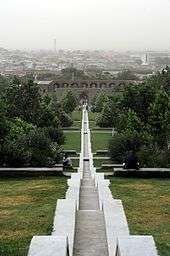Tourism in Afghanistan
The tourism industry of Afghanistan, developed with government help in the early 1970s, has been negligible since 1979 due to internal political instability. A passport and visa are required for entrance into Afghanistan. In 1999, the UN estimated the daily cost of staying in Kabul at $70 USD. Approximately 61% of these costs were estimated to be the price of a room in a guesthouse. It also has a high rate for hotels. Travel was highly restricted in the country due to the US-led campaign against the Taliban and al-Qaeda.
Afghan embassies issue between 15,000 and 20,000 tourist visas annually.[1] In 2014, bookings for adventure trips were doubled in Afghanistan.[2]
Places
Indus Valley Civilization cities
The Indus Valley Civilization (IVC) was a Bronze Age civilization (3300-1300 BC; mature period 2600-1900 BC) extending from what today is northwest Pakistan to northwest India and northeast Afghanistan.[3] An Indus Valley site has been found on the Oxus River at Shortugai in northern Afghanistan.[4] Apart from Shortughai tourists can visit Mundigak in southern Afghanistan which is another notable site.
National Museum of Afghanistan

The museums collection had earlier been one of the most important in Central Asia,[5] with over 100,000 items dating back several millennia. With the start of the civil war in 1992, the museum was looted numerous times resulting in a loss of 70% of the 100,000 objects on display.[6] Since 2007, a number of international organizations have helped to recover over 8,000 artifacts, the most recent being a limestone sculpture from Germany.[7] Approximately 843 artifacts were returned by the United Kingdom in 2012, including the famous 1st Century Bagram Ivories.[8]
Babur Gardens

The Gardens of Babur is a historic park in Kabul, Afghanistan, and also the last resting-place of the first Mughal emperor Babur. The gardens are thought to have been developed around 1528 AD (935 AH) when Babur gave orders for the construction of an ‘avenue garden’ in Kabul, described in some detail in his memoirs, the Baburnama. Lonely Planet describes the park as the loveliest spot in Kabul.[9]
The Kabul Zoo
Another place of interest is the Kabul Zoo. It is located in Kabul, Afghanistan, on the bank of the Kabul River. As of 2010, the zoo has about 280 animals, which includes 45 species of birds and mammals and 36 species of fish.[10] Among the animals there are two lions and Afghanistan's only pig. As many as 10,000 people visit during the weekends.[11]
References
- ↑ Despite Taliban Threat, Afghanistan Manages to Entice Some Tourists
- ↑ http://www.dailymail.co.uk/travel/travel_news/article-2889853/Bookings-adventure-trips-Afghanistan-DOUBLE-curious-travellers-defy-Foreign-Office-advice-pay-5-000-visit-troubled-country.html
- ↑ The Ancient Indus: Urbanism, Economy, and Society. p.1
- ↑ Kenoyer, Jonathan Mark (1998). Ancient cities of the Indus Valley Civilization. pp.96
- ↑ Girardet, Edward; Jonathan Walter, eds. (1998). Afghanistan. Geneva: CROSSLINES Communications, Ltd. p. 291.
- ↑ News, Alastair Lawson BBC. "Afghan gold: How the country's heritage was saved". BBC News. Retrieved 2015-10-30.
- ↑ (31 January 2012) Germany returns Afghan sculpture bbc.co.uk/news/
- ↑ (19 July 2012) Looted art returned to Afghanistan, bbc.co.uk
- ↑ http://www.lonelyplanet.com/afghanistan/kabul/sights/parks-gardens/babur-s-gardens
- ↑ Kabul Zoo provides a haven for humans by Tony Perry of the Los Angeles Times, January 7, 2010.
- ↑ "Afghanistan's only pig quarantined in flu fear". Reuters. 2009-05-05. Retrieved 2015-10-30.
See also
External links
| Wikivoyage has a travel guide for Afghanistan. |
- Afghanistan's bid to boost tourism BBC News, August 22, 2011
- Afghan Directory - tourism companies, airlines, media, embassies
- Afghani local tourism agency ; "Let's be friends - Afghanistan"
